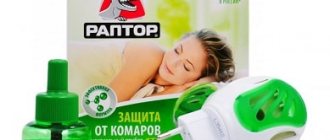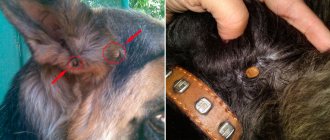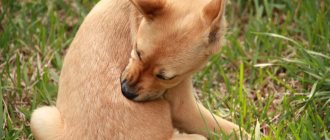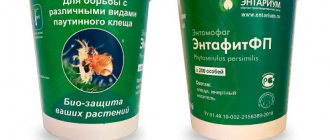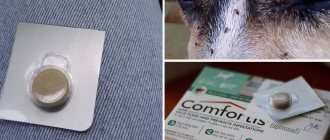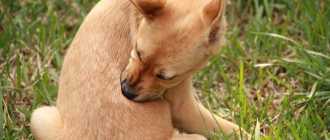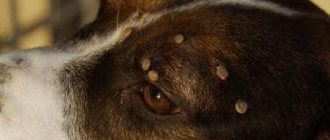Fleas in dogs: description, danger, how they appear
These insects feed on the blood of the animal, but do not always live on it. They can be found on your dog's bedding or elsewhere in the house. They bite humans, cats and other animals that are closer than the carrier of their favorite blood type. They are hardy, quickly adapt to temperature changes and do not die when the ambient temperature drops, but slow down the life processes in the body and wait out unfavorable times. They also develop resistance (addiction) to some insecticides.
The life cycle of an insect is complete, that is, each individual, before adulthood (the fourth stage of life), goes through three more stages - eggs, larvae, pupae. Under ideal conditions they live up to two years, but in practice this period is often shorter - no more than two months.
There are several effective ways to help your beloved dog, but to do this you need to be sure that it is fleas that are bothering your four-legged friend. Knowledge of the characteristics of insects of this species will help to do this. How and why parasite infection occurs are equally important issues for the effective treatment of dogs.
What do dog fleas look like?
The blood-sucking parasite has a small (up to 4 mm in length), laterally flattened dark brown body, a small head and three pairs of limbs. Its hind legs are longer than its front legs and have eight bristles, unlike the cat species, which have six. This allows the insect to stay firmly on the fur and jump far and high in case of danger or in order to quickly move from a victim to another carrier.
Fleas are smaller than ticks and darker than lice eaters.
How do they start
It is a misconception that a pet can become infected with parasites only from yard dogs. This can even happen at home, for example, if a person brings eggs or adult fleas into the home on clothes or shoes. The insect may accidentally enter the room from neighbors. And getting infected while walking in the park is even more likely if you do not use protective equipment.
How to tell if an animal is bothered by fleas
Taking a close look at the dog, it is easy to verify the presence of blood-sucking insects. The signs that they are wounded are as follows:
- restless behavior of the animal,
- itching and desire to scratch constantly,
- the presence of redness and wounds on the pet’s skin,
- the appearance of small white grains on the fur (eggs) or dark dots - traces of the vital activity of parasites,
- live adults on a comb for caring for the animal's fur.
How dangerous are blood-sucking parasites for dogs and humans?
In addition to the discomfort caused by bites, fleas are carriers of fungal infections, helminths, and pathogens of serious diseases - plague, typhus, scabies, piroplasmosis. And since they bite not only animals, but also people, the dog owner and his household have a chance of becoming infected. Although it is minimal. Most often, bites pass with minimal consequences, which are expressed in the form of itchy wounds and redness of the skin. But some dogs and people experience an allergic reaction, which is accompanied by:
- swelling,
- severe redness and inflammation of the affected areas,
- difficulty breathing,
- chills and fever,
- intestinal disorders,
- suppuration of wounds.
This manifests itself as a reaction to the parasite's saliva, which the flea injects during the puncture. And it is this that causes itching, allergic reactions, hair loss and infections. And in puppies and pregnant dogs with numerous bites, anemia is likely to develop.
If signs of an allergy appear after a flea bite, take an antihistamine and seek help from a doctor or veterinarian.
What to process?
Before starting sanitization, it is necessary to remove all foreign objects and debris from the enclosure. The following disinfectants are currently commercially available.
- 3% creolin emulsion , diluted in warm water to a transparent milky color. The solution is applied to the walls, ceiling and floor from a spray bottle or from a hydraulic remote control. Solution consumption – 0.5 l per m2.
- A 0.25% solution of caustic soda in water, the hot composition is more effective. After disinfection, the room is ventilated for at least an hour.
These substances cope very effectively with any microflora, but they are not able to eliminate unpleasant odors. After treatment, the walls and floor must be washed with water.
- Another modern substance that has become widespread is Laina. The product perfectly disinfects and eliminates unpleasant odors. Concentrated and very economical liquid is diluted in an amount of 5 ml per 1 liter of water. It has a wide spectrum of action against pathogens of fungal, viral and bacterial diseases. It has a pleasant lavender scent and has wonderful deodorizing and cleaning properties. You can also use it for washing bowls and other accessories used to care for your pet.
Protects all surfaces from mold and mildew and does not destroy them over time. The drug is low-toxic, so treatment by washing can be done in the presence of animals and people. Short exposure – 20-30 minutes. This time can be spent walking your pet. It is not necessary to ventilate the enclosure or wash off the solution after treatment.
- Another extremely effective product is “TH4+ Disinfectant”. Even more beneficial than the previous one: diluted in a concentration of 1: 200 or 1: 500. The product is active against microorganisms, mycoplasmas, viruses that cause diseases such as corona, adenovirus, parvovirus, hepatitis and canine distemper. Has a fungicidal effect.
The diluted product is also safe for cleaning in the presence of a dog. Has deodorizing properties. It is a green liquid with a fir aroma.
- Virkon S is also used to disinfect room surfaces and treat drinking systems and bowls. The only negative: it is used in the absence of animals in the room. Spraying is carried out using a respirator and rubber gloves. Processing time – 10 minutes. After sanitizing, all surfaces must be thoroughly washed.
For disinfestation, the following types of preparations are used, which have repellent properties and have a detrimental effect on insects.
- "Diazinon S". The drug is diluted in a concentration of 20 ml per bucket of water. Disinsection is carried out using a spray bottle, thoroughly treating all surfaces once every 7-10 days.
- A variety of this drug is “Clemit” . It also contains diazinon at a concentration of 60%.
- "Delcid" . To treat the enclosure, use diluted (1 ampoule per 1.6 liters of water). All surfaces are sprayed with a spray bottle. The drug can be used to sanitize the dog itself, only in a lower concentration.
How to remove fleas from a dog at home
The peculiarity of the fight against these parasites is that even after the destruction of adult individuals, their larvae and eggs, one cannot be sure that the dog is forever protected from fleas. You will need to regularly carry out preventive measures and monitor your pet’s hygiene and behavior. Another difficulty is the need to process not only the animal, but also the space surrounding it - booth, house, etc.
Without food, fleas live up to six months.
Basic rules for treating adult dogs for fleas
The general tactics for removing fleas from a dog look like this:
- Determine whether fleas are really bothering your pet.
- Use anti-flea products, taking into account the age and other characteristics of the dog.
- Treat the room using insecticidal preparations.
- Protect adult dogs and especially puppies from the appearance of parasites (preventive treatment with sprays, drops every two to three months.
Anti-flea products
Drugs in this category are presented in the form:
- shampoos,
- drops,
- aerosol insecticides,
- tablets,
- powders,
- collars.
To choose the right product, it is better to consult a veterinarian. Some species have contraindications for use in pregnant or older dogs, puppies, or sick dogs. It is also important to ensure that there is no individual intolerance to the components of the drug. This is usually written in the instructions, so read it carefully before use. Any doubts are a reason to refuse to independently prescribe the chosen remedy or seek advice from a specialist.
Shampoos
The safest form of protection against parasites is shampoos. They have a gentle effect on the animal’s body, almost do not cause poisoning or other adverse reactions, and are often recommended by veterinarians for treating weak, pregnant dogs and puppies. Their effectiveness in fighting fleas is high, the price is affordable and can always be found in the pharmacy. An additional advantage of using shampoos is the caring effect of the product on your pet’s skin and coat.
Disadvantages of shampoos:
- application, compared to spray or collars - bathing a dog is not as simple as spraying its fur with an aerosol insecticide,
- minimal protective time due to the lack of residual effect, which means the need for constant use.
They are produced by most manufacturers of anti-flea products for animals - Beafar, Rolf Club, Celandine, Bars and others.
Drops
This is an easy-to-use and long-lasting form of anti-flea treatment. The drops contain insecticides permethrin, imidacloprid, phenothrin and other types that have a nerve-paralytic effect on insects. By placing the drug on the withers, you can protect your pet from parasites for several weeks. And if you choose and use the drug correctly, allergic reactions and side effects are unlikely.
For the treatment of nursing dogs and puppies under 2-3 months of age, most drops are prohibited.
Table: comparative characteristics of flea drops for dogs
| Name | Active substance | From what age are drops allowed, months | Protection period, weeks |
| Beaphar | Diazinon | 6 | 3 |
| Dana Ultra Neo | 2,5 | 8 | |
| Advantix |
| 7 | 6–8 |
| Frontline | Fipronil | 2,5 | 8 |
| Stronghold | Selamectin | 1,5 | 6–8 |
| Bars Forte |
| 2 | 8 |
| Celandine |
|
Collars
Insecticidal collars are easy to use and safe for animals. They can be chemical or biological. The latter do not have a toxic effect on the body, because they contain only natural ingredients. But even in chemical models, the daily dose of the toxic component is calculated with such precision that while killing parasites, it has no effect on healthy adult dogs. It is better for puppies and pregnant dogs not to use such collars or to choose products that are approved for them.
There are also ultrasonic flea collars. But their high price does not correspond to their effectiveness, so they are rarely used.
The disadvantage of wearing collars is the uneven impact due to the limited area of impact - the neck. They also cannot be combined with insecticides in another form, such as drops.
Insecticidal sprays
Such preparations, like others, contain insecticides and repellents that are harmful to fleas. But in the form of an aerosol they act faster - at the moment of contact with the parasite. Their advantages:
- safety for the pet,
- no need for re-processing during the protective time specified in the instructions,
- ease of use,
- availability both in price and availability in pharmacies and veterinary stores.
The disadvantage of sprays is toxicity, the likelihood of allergic reactions and contraindications for use by pregnant and lactating animals, puppies up to two to three months.
Table: characteristics of different types of flea sprays for dogs
| Name | Active ingredient | From what age is it used, months | Protection period, weeks |
| Frontline | Fipronil | 6 | 6–8 |
| Bars Forte | 3 | 8 | |
| Hartz | Tetrachlorvinphos | 7 | 1 |
| Bolfo | Propoxur | 33 | 1–2 |
| Beaphar | Margosa and lavender oils | a few days |
Pills
In this form, they produce remedies for blood-sucking parasites and infectious diseases that they transmit to animals after a bite, based on afoxolaner and fluralaner. These substances belong to a new class of isoxazolines and kill many dog pests. The advantages of the tablets are the absence of side effects, safety for sick and old dogs and puppies from 2-4 months of age. They have a pleasant taste, so the animal has no problem eating them. The most famous tablets are Bravecto, Simparica, Frontline Nexgard.
Powder
Insecticidal powders are used to prevent and treat infection with ectoparasites in dogs. They are not intended for weakened animals, pregnant women and puppies under 2 months. The active substance is peritroids, which have a poisonous effect on fleas upon contact with them. They are rubbed into the fur and skin of pets, avoiding mucous membranes. An example of such a product is Insectal powder. Preparations based on natural ingredients are also used, for example, Sanal powder.
Traditional methods of treating dogs for fleas
You can remove parasites at home without the use of chemicals, but with the help of accessible, safe and cheap means:
- Herbal Fleas are repelled by the specific smell and bitter taste of wormwood. Prepare a decoction from it for bathing the animal - 1 tbsp. l. for 1 liter of water. Instead of wormwood, also use eucalyptus or tansy.
- Essential oils. The aromas of lavender, tea tree, citrus and eucalyptus repel blood-sucking parasites. Prepare a spray from them: mix five drops of one or more oils with 100 g of water and spray the dog with the product before going outside to prevent flea infestation.
- Laundry soap. Grate the block, add a glass of warm water, leave for two hours. Then add the chopped onion, mix, apply to the dog’s coat for five minutes and rinse with water. If there are a lot of fleas, repeat the treatment several more times at once. Prepare also medicated shampoo. To do this, instead of onions, add 3 drops of cedar or tea tree oil to the soap solution. The effect of the composition will be enhanced if the grated soap is infused not in plain water, but in a decoction of eucalyptus. Apply the shampoo to the dog's coat for 10 minutes and rinse off.
- Onions and garlic. Chop half an onion or two medium cloves of garlic and add a glass of water, and then leave for eight hours. Use the resulting product to wipe the animal’s neck and head, as well as other places from which it is impossible to lick the infusion.
- Pine sawdust. Place them under your pet's bedding or sprinkle them in and around the kennel to repel vermin.
- Vinegar. Mix it with water in a ratio of 1:3 and treat the dog’s fur, and after an hour, comb it with a thick comb to remove dead fleas, their eggs and larvae.
How to remove fleas from puppies
The difficulty in treating puppies is that most anti-flea products are approved for use from 6–7 months. And only some can be used to treat 1.5–2 month old babies. The safest preparations for them are those in the form of shampoo and those containing natural ingredients. To treat the smallest dogs, including those who are not yet a month old, use folk remedies - daily washing with tar soap or bathing in a decoction of wormwood, homemade shampoo based on laundry soap and eucalyptus. Strive to create all the conditions to prevent flea infestation.
Table: means for removing fleas in puppies from 1.5 and 2 months
| Name | Release form | From what age, months |
| Stronghold | Spray | 1,5 |
| Leopard | ||
| Frontline spot | Drops | 2 |
| Celandine | ||
| Beaphar | Collar | |
| Hartz | ||
| Celandine | Shampoo | 1,5 |
| Phytoelite | ||
| Beaphar | ||
| Doctor Zoo |
Video: preventing fleas in puppies
How to save a pregnant and lactating dog from fleas
Use the same recommendations as for puppies to remove fleas from these dogs. There are drugs that are suitable for treating pregnant women - PRAK-Tik Frontline-Combi drops, some collars. But nursing mothers are only allowed those that are suitable for puppies. The best option is to use anti-flea shampoos based on natural ingredients:
- Doctor Zoo - contains extracts of chamomile, red pepper, thyme and sage oils,
- Celandine - contains small amounts of permethrin, aloe vera extract and coconut oil.
We were treated against ticks during pregnancy and feeding of puppies with PRAK-TIK. It is approved for use by pregnant and lactating bitches.
carvette
https://pesiq.ru/forum/showthread.php?t=19607
As for flea treatment, Frontline-Combi is approved for pregnant women and there is still a new drug, American, I forgot the name, it can also be treated for pregnant women!!!
Stay630
https://www.liubava.ru/forum/showthread.php?t=22156
Flea remedies from pet pharmacies and pet stores
Now let's move on to flea remedies that you can find in pharmacies and pet stores. First of all, these are flea shampoos . I would like to note that shampoos produced in the CIS countries have very low effectiveness. Therefore, it is recommended to buy shampoos only from trusted manufacturers. After washing your dog with shampoo, you should comb it thoroughly. A clean dog will very quickly get new residents again if its kennel is not thoroughly treated.
Antiparasitic collars often cannot help rid your dog of fleas. Especially if the dog has thick and long hair. Often such collars cause allergies in the animal. You need to know exactly what is included in the collar. For example, pyrethroids. Preparations from the pyrethroid group have a low cost, but over the years their effectiveness has become increasingly lower. In addition, information began to appear that pyrethroids are also dangerous for humans.
Sprays and solutions based on pyrethroids. Ampoules containing solutions with pyrethroids must be diluted in water and rubbed into the dog’s fur or sprayed. As mentioned above, these products are toxic to humans and dogs.
Spot-on - disposable pipettes that contain drops on the withers. At the moment, these are the most effective flea remedies. The best of them are Stronghold and Frontline. The drug Stronghold is dripped onto the withers and the medicine gradually disperses throughout the dog’s body through the blood. It is fatal not only to fleas, but also to roundworms and ticks. Its validity period on a dog is 1 month. The drug Frontline spreads on the dog's skin, is fatal to all parasites, is not absorbed into the blood and internal organs, and lasts for 3 months on the dog. It is also completely safe for people and dogs. Suitable for puppies. Works great against flea larvae. It is good because it destroys all parasites around it (bedding, floor, furniture).
The consequences of a flea infestation on your dog may include the fact that fleas carry diseases that can be transmitted to humans. This could be plague, tuberculosis, hepatitis C and B, giardiasis, salmonellosis and other diseases. Also, for the dogs themselves there is a danger of diseases such as infection with helminths (among them the “cucumber tapeworm”, a helminth that lives in the small intestines of humans and dogs and can reach a length of up to 1.5 m), dermatitis, anemia in puppies and other diseases.
How can you get rid of fleas from a dog that lives outside in a kennel? Folk remedies help, but not always. On many forums, people are divided into advocates of killing fleas using folk remedies and their opponents. Dog breeders fiercely defend their positions. Traditional methods are based mainly on repelling fleas with an unpleasant odor. But increasingly, fleas get used to new realities and do not react to a bunch of wormwood inside the booth. Perhaps the best option would be to combine store-bought drugs and traditional methods.
How do you get rid of fleas from your dog that lives outside in a kennel? Share with us.
Post Views: 23
Anti-flea treatment of premises
To solve the problem of infecting four-legged animals with blood-sucking parasites, it is necessary not only to cure the animal, but also to destroy all the fleas that remain in the house. If this is not done, the reappearance of insects cannot be avoided.
How to get rid of dog fleas in an apartment and private house
Disinsection of premises is carried out in one of four ways or a combination of them:
- Chemical. Using preparations based on insecticides - permethrin, fipronil, organophosphorus compounds - you can independently destroy insects in the house. They are available in the form of sprays, powders and concentrated solutions. Aerosols act quickly, but only on contact with fleas. All surfaces in the room are treated with solutions, and powders are scattered in all places where parasites live - under baseboards and window sills, in animal bedding, in furniture, in all corners. The most effective remedies are sprays against crawling insects Raptor and Reid, Karbofos concentrate, Phenaxin powder and others.
- Mechanical. Fleas will die if you open the windows and doors in the house a little often when the frost outside is below -20 degrees. The danger of this method is that utility lines may be damaged. If you know where parasites accumulate, you can simply scald them with boiling water. Another option is to increase the room temperature to +50 degrees. This can be done using a heat gun, but renting one is not cheap.
- Professional. Such processing involves calling specialists who use the hot or cold fog method in their work. The principle of their operation is to generate tiny drops of insecticidal solution, which penetrate into the most inaccessible places and ensure the rapid destruction of a large population of parasites. They resort to the help of specialists when there is a very strong flea infestation, when household methods do not give the expected effect.
- Folk. Many people prefer to first try safe, inexpensive, although not always effective, folk methods, and only then buy chemicals or call specialists. To combat fleas in a house or apartment, use soda, salt, herbs (wormwood, tansy), kerosene, pine sawdust, and garlic. Concentrated decoctions or solutions are made from them; dry substances are simply rubbed into carpets and other surfaces. Their action is based more on repelling insects than killing them. Although fleas will die from kerosene. The main disadvantage of such methods is the inability to reach every individual in the room, which reduces efficiency. But they are good for prevention.
Permethrin-based insecticides affect only adults and larvae, while organophosphates also kill flea eggs.
Photo gallery: chemical and folk remedies for controlling fleas in the home
Spray insecticidal aerosols in areas where parasites are most concentrated
Phenaxin powder is scattered in corners, under baseboards, behind furniture and in other places where fleas may live.
Karbofos is one of the most effective means for combating fleas
Garlic repels fleas and other blood-sucking parasites from the home
Rub soda and salt on floors and carpets to get rid of fleas
A decoction of tansy is used to wash surfaces in a house infested with fleas.
How to treat the booth
If a dog lives in a country house or in a private house, its house is also treated for fleas. For this purpose, the same means are used as for human habitation. Replace the litter, as pest larvae often live in it. To prevent them from infesting, scatter pine sawdust around the booth or plant wormwood bushes nearby. This will repel insects.
Danger of tick bites for dogs
If a dog is bitten by a tick that was not detected and eliminated in time, there is a high risk that a very dangerous disease will begin to develop - piroplasmosis (or babesiosis). With the saliva of the tick, after 36-48 hours, Babesia parasites enter the dog’s bloodstream, which destroy red blood cells and have a severe toxic effect. Symptoms of the disease:
- increase in body temperature up to 41 degrees;
- depressed state;
- lack of appetite;
- vomit;
- diarrhea with blood clots in stool;
- change in the color of urine to a brown tint;
- yellow color of mucous membranes.
Curing piroplasmosis is extremely difficult and takes a long time.
If measures are not taken in a timely manner, death occurs within 3-5 days. Additional Information! Piroplasmosis can occur in a chronic form without severe symptoms. In this case, parasites can only be detected in a dog’s body through tests.
Types of protective equipment
The best way to protect your pet from parasites is to treat dogs against ticks using specialized compounds. They are selected individually after the pet has been examined by a veterinarian. The same protective drug can have different effects on animals depending on their health status and the presence or absence of chronic diseases.
Among all the variety of products, it is better to select the most effective one with a veterinarian
Drops
This is a universal remedy that is applied to the skin at the withers. Pros:
- wide spectrum of action - they can protect against ticks, fleas and other parasites;
- ease of use;
- long period of exposure.
Flaws:
- high toxicity;
- cost – from 150 to 2000 rubles*;
- the risk that the animal will lick the liquid from the withers, causing damage to its health.
When lubricating the withers, the person must also take precautions. Do not allow liquid to come into contact with mucous membranes; after treating your pet, you must wash your hands thoroughly.
Recommended drops:
- Palladium Golden Defense;
- Stronghold;
- Mega Stop Provet;
- Bayer Advocate.
Attention! Due to its high toxicity, applying the composition to clean skin is prohibited. At least 5 days must pass between bathing and using the protective fluid so that the fat layer has time to form. After applying the composition to the withers, you can bathe your pet no earlier than 4-6 days later.
Collars
A collar is one of the most common ways to prevent tick bites, but its effectiveness cannot be called high. Before putting a collar on a dog, you need to place it next to it overnight and monitor it for the development of possible allergic reactions. They can manifest themselves in the form of a rash, nausea, and lethargy.
Pros:
- long service life - up to six months;
- there is no need to remove it before bathing your dog.
Minuses:
- low reliability;
- chafing of the skin in breeds with short hair;
- activation of the active components occurs a few days after putting it on.
Additional Information! Due to its low effectiveness, the collar is not recommended for use for animals that are often in country houses, forests and other places with high vegetation, where the risk of being bitten by a tick is much higher than during city walks.
Recommended:
- Beapher;
- "ProfiLine";
- Foresto.
Collar to protect dogs from parasites
Shampoos
Only a pet that leads a predominantly domestic lifestyle and rarely has contact with nature can be protected with shampoo.
Positive aspects of using shampoos:
- ease of use;
- pleasant aroma;
- providing a bactericidal effect.
Flaws:
- high risk of an allergic reaction if shampoo gets on the dog’s mucous membranes;
- low efficiency;
- short service life of components.
It is not possible to protect your pet with shampoo alone; its use must be combined with other methods, for example, wearing a collar.
Recommended shampoos:
- Trixie;
- Ultra Guard Hartz;
- "Amiwe";
- Happs.
Sprays
Sprays are very popular due to their advantage of instantaneous action. This is a very important property when it is necessary to protect an animal in the village or before spending time in a forest belt.
This method is not without its disadvantages:
- toxic composition, which is why the animal can only be processed outdoors;
- difficulty in dosage;
- Contraindications – cannot be used during pregnancy, weak immunity due to chronic diseases, acute diseases.
Additional Information! Despite the immediate effect, another drawback of sprays is that dogs must be treated with them regularly. If you skip the next treatment, it is unlikely that you will be able to save your dog from the risk of being bitten by a tick.
Recommended:
- "Rolf Club";
- "Fipronil";
- "Leopard";
- Hartz.
Pills
The active substances contained in the tablets accumulate in the blood plasma. Ticks, as a rule, do not bite such animals. Even if the bite could not be avoided, the diseases that ticks carry cannot be transmitted to the dog. Pros of pills:
- ease of use;
- reliability and high efficiency;
- Duration of exposure is up to 12 weeks.
Flaws:
- it is forbidden to mix with other medicines;
- the need for precise dosage;
- risk of side effects;
- you cannot skip the next appointment;
- should not be given to animals under 2 years of age.
It will not be difficult for your dog to swallow the pills, since they come in the form of dog treats
. Recommended:
- "Bravecto";
- "NexgarD";
- Simparica.
Precautionary measures
When working with chemicals, follow the safety rules:
- Choose products for treating dogs wisely, taking into account the concentration of active ingredients, the age and condition of the pet.
- Use approved medications for puppies and pregnant dogs.
- Do not use products or collars that have expired.
- Follow the instructions in the instructions when handling animals. If your dog reacts poorly to the medication, stop taking it and contact your veterinarian.
- Do not overdose.
- When treating rooms with chemicals, remove small children and pets from the room.
- Use protective gloves and a mask, and goggles when working with aerosols.
- After treating the room, leave it for several hours. Usually the instructions indicate this time.
- Do not place insecticidal powders in areas accessible to children or small animals.
- Wash your hands and face, wash clothes after use.
Prevention of re-infection with blood-sucking parasites
To prevent parasites from getting in puppies and adult dogs:
- keep your pets clean,
- put collars on them when you go for a walk,
- do not let go into basements and other places where there is a high probability of infection,
- do not allow contact with sick animals,
- use special prophylactic drugs,
- Keep your dog's sleeping area clean and closely monitor his behavior so you can immediately begin fighting parasites.
Anti-flea drugs quickly and effectively rid dogs of blood-sucking parasites. Choose them according to your pet's characteristics so as not to harm him. Do not forget that prevention will help avoid serious infection and its consequences.
How to treat the booth
After you have partially disassembled the kennel, it is necessary to carry out its initial cleaning, during which dog waste products, small debris and other attributes of dog living are removed from the sleeping area and from the inner lining. Next, the facade and bottom of the dog apartment are thoroughly cleaned.
As a substance suitable for processing, you can choose a formaldehyde solution, an aqueous sodium hydroxide emulsion or a creolin solution. Most dog owners whose pets live in kennels use a three percent solution of creolin dissolved in warm water as a treatment for the dog house. To prepare a solution of sodium hydroxide, you need to mix 25 grams of the active substance with 10 liters of water.
It is better to apply chemical compounds to the structure of the booth and its removed elements using a sprayer or a heavily wetted broom. When applying, make sure that the solution penetrates into all cracks and cavities.
